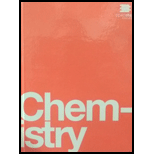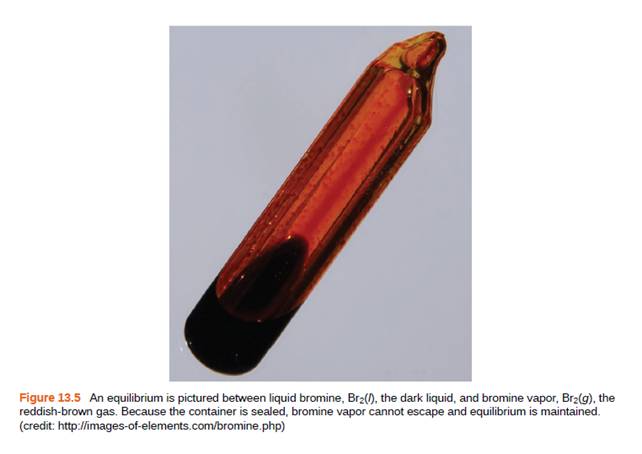
Chemistry by OpenStax (2015-05-04)
1st Edition
ISBN: 9781938168390
Author: Klaus Theopold, Richard H Langley, Paul Flowers, William R. Robinson, Mark Blaser
Publisher: OpenStax
expand_more
expand_more
format_list_bulleted
Textbook Question
Chapter 13, Problem 7E
Explain why an equilibrium between Br2(l) and Br2(g) would not be established if the container were not a closed vessel shown in Figure 13.5.

Expert Solution & Answer
Trending nowThis is a popular solution!

Students have asked these similar questions
PLEASE HELP! URGENT!
"Water gas" is an industrial fuel composed of a mixture of carbon monoxide and hydrogen gases. When this
fuel is burned, carbon dioxide and water result. From the information given below, write a balanced equation
and determine the enthalpy of this reaction:
CO(g) + O2(g) → CO₂(g) + 282.8 kJ
H2(g) + O2(g) → H₂O(g) + 241.8 kJ
MacBook Air
Page of 3
4. Calculate AG for the following reaction at 25°C. Will the reaction occur (be spontaneous)? How do you
know?
NH3(g) + HCl(g) → NH4Cl(s)
AH=-176.0 kJ
AS-284.8 J-K-1
Chapter 13 Solutions
Chemistry by OpenStax (2015-05-04)
Ch. 13 - What does it mean to describe a reaction as...Ch. 13 - When writing an equation, how is a reversible...Ch. 13 - If a reaction is reversible, when can it be said...Ch. 13 - Is a system at equilibrium if the rate constants...Ch. 13 - If the concentrations of products and reactants...Ch. 13 - Explain why there may be an infinite number of...Ch. 13 - Explain why an equilibrium between Br2(l) and...Ch. 13 - If you observe the following reaction at...Ch. 13 - Among the solubility rules previously discussed is...Ch. 13 - Among the solubility rules previously discussed is...
Ch. 13 - Benzene is one of the compounds used as octane...Ch. 13 - Show that the complete chemical equation, the...Ch. 13 - For a titration to be effective, the reaction must...Ch. 13 - For a precipitation reaction to be useful in a...Ch. 13 - Write the mathematical expression for the reaction...Ch. 13 - Write the mathematical expression for the reaction...Ch. 13 - The initial concentrations or pressures of...Ch. 13 - The initial concentrations or pressures of...Ch. 13 - The following reaction has KP=4.50105 at 720 K....Ch. 13 - Determine if the following system is at...Ch. 13 - Which of the systems described in Exercise 13.15...Ch. 13 - Which of the systems described in Exercise 13.16...Ch. 13 - For which of the reactions in Exercise 13.15 does...Ch. 13 - For which of the reactions in Exercise 13.16 does...Ch. 13 - Convert the values of KC to values of KP to the...Ch. 13 - Covert the values of Kc to the values of KP or the...Ch. 13 - What is the value of the equilibrium constant...Ch. 13 - Write the expression of the reaction quotient for...Ch. 13 - Write the reaction quotient expression for the...Ch. 13 - What is the approximate value of the equilibrium...Ch. 13 - The following equation represents a reversible...Ch. 13 - Explain how to recognize the conditions under...Ch. 13 - What property of a reaction can we use to predict...Ch. 13 - What would happen to the color of the solution in...Ch. 13 - The following reaction occurs when a burner on a...Ch. 13 - A necessary step in the manufacture of sulfuric...Ch. 13 - Suggest four ways in which the concentration of...Ch. 13 - Suggest four ways in which the concentration of...Ch. 13 - How will an increase in temperature affect each of...Ch. 13 - How will an increase in temperature affect each of...Ch. 13 - Water gas is a 1:1 mixture of carbon monoxide and...Ch. 13 - Nitrogen and oxygen react at high temperatures....Ch. 13 - Water gas, a mixture of H2 and CO, is an important...Ch. 13 - Pure iron metal can be produced by the reduction...Ch. 13 - Ammonia is a weak base that reacts with water...Ch. 13 - Acetic acid is a weak acid that reacts with water...Ch. 13 - Suggest two ways in which the equilibrium...Ch. 13 - How can the pressure of water vapor be increased...Ch. 13 - Additional solid silver sulfate, a slightly...Ch. 13 - The amino acid alanine has two isomers, -alanine...Ch. 13 - A reaction is represented by this equation:...Ch. 13 - A reaction is represented by this equation:...Ch. 13 - What is the value of the equilibrium constant at...Ch. 13 - Hydrogen is prepared commercially by the reaction...Ch. 13 - A 0.72-m01 sample of PCl5 is put into a 1.00-L...Ch. 13 - At 1 atm and 25 C, NO2 with an initial...Ch. 13 - Calculate the value of the equilibrium constant Kp...Ch. 13 - When heated, iodine vapor dissociates according to...Ch. 13 - A sample of ammonium chloride was heated in a...Ch. 13 - At a temperature of 60 C, the vapor pressure of...Ch. 13 - Complete the changes in concentrations (or...Ch. 13 - Complete the changes in concentrations (or...Ch. 13 - Why are there no changes specified for Ni in...Ch. 13 - Why are there no changes specified for NH4HS in...Ch. 13 - Analysis of the gases in a sealed reaction vessel...Ch. 13 - Calculate the number of moles of HI that are at...Ch. 13 - What is the pressure of BrCl in an equilibrium...Ch. 13 - What is the pressure of CO2 in a mixture at...Ch. 13 - Cobalt metal can be prepared by reducing cobalt...Ch. 13 - Carbon reacts with water vapor at elevated...Ch. 13 - Sodium sulfate 10-hydrate, Na2SO410H2O, dehydrates...Ch. 13 - Calcium Chloride 6-hydrate, CaCl26H2O, dehydrates...Ch. 13 - A student solved the following problem and found...Ch. 13 - A student solved the following problem and found...Ch. 13 - Assume that the change in concentration of N2O4 is...Ch. 13 - Assume that the change in concentration of COCI2...Ch. 13 - Assume that the change in pressure of H2S is small...Ch. 13 - What are all concentrations after a mixture that...Ch. 13 - What are the concentrations of PCl5, PCl3, and Cl2...Ch. 13 - Calculate the pressures of all species at...Ch. 13 - Calculate the equilibrium concentrations of NO,...Ch. 13 - Calculate the equilibrium concentrations that...Ch. 13 - One of the important reactions in the formation of...Ch. 13 - Calculate the pressures of NO, Cl2, and NOCI in an...Ch. 13 - Calculate the number of grams of HI that are at...Ch. 13 - Butane exists as two isomers, n -butane and...Ch. 13 - What is the minimum mass of CaCO3 required to...Ch. 13 - The equilibrium constant (Kc) for this reaction is...Ch. 13 - At 25 C and at 1 atm, the partial pressures in an...Ch. 13 - In a 3.0-L vessel, the following equilibrium...Ch. 13 - The equilibrium constant (Kc) for this reaction is...Ch. 13 - Antimony pentachloride decomposes according to...Ch. 13 - Consider the reaction between H2 and O2 at 1000...Ch. 13 - An equilibrium is established according to the...Ch. 13 - Consider the equilibrium...Ch. 13 - The binding of oxygen by hemoglobin (Hb), giving...Ch. 13 - The hydrolysis of the sugar sucrose to the sugars...Ch. 13 - The density of trifluoroacetic acid vapor was...Ch. 13 - Liquid N2o3 is dark blue at low temperatures, but...Ch. 13 - A 1.00-L vessel at 400 C contains the following...Ch. 13 - A 0.010 M solution of the weak acid HA has an...
Additional Science Textbook Solutions
Find more solutions based on key concepts
1. Why is the quantum-mechanical model of the atom important for understanding chemistry?
Chemistry: Structure and Properties (2nd Edition)
What percentage of Earths land surface do glaciers presently cover? ____________
Applications and Investigations in Earth Science (9th Edition)
4. What five specific threats to biodiversity are described in this chapter? Provide an example of each.
Biology: Life on Earth (11th Edition)
Match the people in column A to their contribution toward the advancement of microbiology, in column B. Column ...
Microbiology: An Introduction
15. A good scientific hypothesis is based on existing evidence and leads to testable predictions. What hypothes...
Campbell Biology: Concepts & Connections (9th Edition)
Draw the mechanism for the reaction of cyclohexene with HCl.
Organic Chemistry (8th Edition)
Knowledge Booster
Learn more about
Need a deep-dive on the concept behind this application? Look no further. Learn more about this topic, chemistry and related others by exploring similar questions and additional content below.Similar questions
- true or false The equilibrium constant for this reaction is 0.20. N2O4(g) ⇔ 2NO2(g) Based on the above, the equilibrium constant for the following reaction is 5. 4NO2(g) ⇔ 2N2O4(g)arrow_forwardtrue or false The equilibrium constant for this reaction is 0.20. N2O4(g) ⇔ 2NO2(g) Based on the above, the equilibrium constant for the following reaction is 0.4. 2N2O4(g) ⇔ 4NO2(g)arrow_forwardtrue or false Using the following equilibrium, if heat is added the equilibrium will shift toward the reactants. N2(g) + 3H2(g) ⇔ 2NH3(g) + heatarrow_forward
- True or False Using the following equilibrium, if heat is added the equilibrium will shift toward the products. N2O4(g) + heat ⇔ 2NO2(g)arrow_forwardtrue or false Using the following equilibrium, if solid carbon is added the equilibrium will shift toward the products. C(s) + CO2(g) ⇔ 2CO(g)arrow_forwardProvide the complete mechanism for the reaction below. You must include appropriate arrows,intermediates, and formal charges. Please also provide a reason to explain why the 1,4-adduct is preferred over the 1,3-adduct.arrow_forward
- Which of the following pairs are resonance structures of one another? I. III. || III IV + II. :0: n P !༠ IV. EN: Narrow_forwardPredict the major organic product(s) and byproducts (either organic or inorganic) for thefollowing reactions.arrow_forwardA 8.25 g sample of aluminum at 55°C released 2500 J of heat. The specific heat of aluminum is 0.900 J/g°C. The density of aluminum is 2.70 g/mL. Calculate the final temperature of the aluminum sample in °C.arrow_forward
arrow_back_ios
SEE MORE QUESTIONS
arrow_forward_ios
Recommended textbooks for you
 Chemistry by OpenStax (2015-05-04)ChemistryISBN:9781938168390Author:Klaus Theopold, Richard H Langley, Paul Flowers, William R. Robinson, Mark BlaserPublisher:OpenStax
Chemistry by OpenStax (2015-05-04)ChemistryISBN:9781938168390Author:Klaus Theopold, Richard H Langley, Paul Flowers, William R. Robinson, Mark BlaserPublisher:OpenStax Chemistry: The Molecular ScienceChemistryISBN:9781285199047Author:John W. Moore, Conrad L. StanitskiPublisher:Cengage Learning
Chemistry: The Molecular ScienceChemistryISBN:9781285199047Author:John W. Moore, Conrad L. StanitskiPublisher:Cengage Learning ChemistryChemistryISBN:9781305957404Author:Steven S. Zumdahl, Susan A. Zumdahl, Donald J. DeCostePublisher:Cengage Learning
ChemistryChemistryISBN:9781305957404Author:Steven S. Zumdahl, Susan A. Zumdahl, Donald J. DeCostePublisher:Cengage Learning Introductory Chemistry: A FoundationChemistryISBN:9781337399425Author:Steven S. Zumdahl, Donald J. DeCostePublisher:Cengage Learning
Introductory Chemistry: A FoundationChemistryISBN:9781337399425Author:Steven S. Zumdahl, Donald J. DeCostePublisher:Cengage Learning Chemistry for Engineering StudentsChemistryISBN:9781337398909Author:Lawrence S. Brown, Tom HolmePublisher:Cengage Learning
Chemistry for Engineering StudentsChemistryISBN:9781337398909Author:Lawrence S. Brown, Tom HolmePublisher:Cengage Learning World of Chemistry, 3rd editionChemistryISBN:9781133109655Author:Steven S. Zumdahl, Susan L. Zumdahl, Donald J. DeCostePublisher:Brooks / Cole / Cengage Learning
World of Chemistry, 3rd editionChemistryISBN:9781133109655Author:Steven S. Zumdahl, Susan L. Zumdahl, Donald J. DeCostePublisher:Brooks / Cole / Cengage Learning

Chemistry by OpenStax (2015-05-04)
Chemistry
ISBN:9781938168390
Author:Klaus Theopold, Richard H Langley, Paul Flowers, William R. Robinson, Mark Blaser
Publisher:OpenStax

Chemistry: The Molecular Science
Chemistry
ISBN:9781285199047
Author:John W. Moore, Conrad L. Stanitski
Publisher:Cengage Learning

Chemistry
Chemistry
ISBN:9781305957404
Author:Steven S. Zumdahl, Susan A. Zumdahl, Donald J. DeCoste
Publisher:Cengage Learning

Introductory Chemistry: A Foundation
Chemistry
ISBN:9781337399425
Author:Steven S. Zumdahl, Donald J. DeCoste
Publisher:Cengage Learning

Chemistry for Engineering Students
Chemistry
ISBN:9781337398909
Author:Lawrence S. Brown, Tom Holme
Publisher:Cengage Learning

World of Chemistry, 3rd edition
Chemistry
ISBN:9781133109655
Author:Steven S. Zumdahl, Susan L. Zumdahl, Donald J. DeCoste
Publisher:Brooks / Cole / Cengage Learning
Chemical Equilibria and Reaction Quotients; Author: Professor Dave Explains;https://www.youtube.com/watch?v=1GiZzCzmO5Q;License: Standard YouTube License, CC-BY